Creamy, lemony goodness can be yours when you make a classic hollandaise sauce. Just a few ingredients and a few minutes over a double boiler are all that’s required. Drizzle on eggs, vegetables, meat, chicken, or fish to brighten up brunch, lunch or dinner!

Jump to:
Why this recipe works
- Homemade hollandaise sauce has a bright, creamy, lemony flavor
- Only uses five ingredients
- Can be used on eggs, vegetables, meat, chicken, and fish and is appropriate for keto, paleo, and whole30 diets
You'll usually encounter Hollandaise sauce at breakfast or brunch - it's the Eggs Benedict sauce, a layering of poached eggs, Canadian Bacon, all atop a toasted English muffin. However, its smooth, creamy, lemony flavor can also enhance dishes like grilled chicken or steak, poached salmon, or roasted or steamed vegetables (like this Instant Pot Asparagus).
You can even deconstruct Eggs Benedict on your plate (for picky eaters, you know who you are!), or use avocado rather than Canadian bacon (serving it "California-style"). Or present the dish an entirely different way with this Eggs Benedict Casserole.
Hollandaise sauce might seem a little intimidating to make, but really it's not, and you don’t have to worry about raw eggs. All you need is some patience, a few ingredients, and a few minutes over a double boiler.
Recipe Ingredients
You'll need the following ingredients to make this hollandaise sauce recipe:

Ingredient Notes
You only need five hollandaise sauce ingredients: butter, egg yolks, lemon juice, salt, and a pinch of cayenne pepper.
Egg yolks: This Hollandaise recipe gently cooks the egg yolks over a double boiler. It is pregnancy- and kid-friendly when the the egg yolks are fully cooked and reach 149˚F on a digital thermometer.
Butter: A classic hollandaise sauce recipe uses warmed melted butter in its preparation. If you want to take it an extra step, clarify the butter before proceeding which removes water and milk solids, leaving only the butterfat behind. This increases the chances of your sauce not breaking because you're removing the extra water from the butter that can weaken the emulsion.
Ghee (aka clarified butter): Frequently used in Indian cuisine, ghee has a much higher smoke point than butter, so you can use it for high temperature cooking. You can purchase ghee in a jar, but it's not hard to make it yourself.
See the recipe card for a full list of ingredients and measurements.
How to Make Hollandaise Sauce
Step 1: Make clarified butter (aka ghee) - optional
Gently heat the butter in a small saucepan (preferably with a lip for pouring) over medium heat. Allow the butter to foam (that’s the water boiling away). Skim off the foam occasionally (photo 1).
Just remember that you’re trying not to toast the milk solids at the bottom of the pan when you’re making clarified butter. Go too far and you have brown butter (which is yummy in its own right, like in Chocolate Chip Cookie bars, but not what we want here).

Step 2: Make the egg yolk base
Place a medium saucepan on the stove with about an inch of water. Heat the water until it’s simmering, then adjust the heat to low.
Combine the egg yolks and lemon juice and whisk until the eggs are pale and frothy. Fit the bowl inside the saucepan (photo 2). Choose a bowl that can fit inside the saucepan (without it touching the bottom) to use as a double boiler.

Step 3: Create the emulsion
With the heat on low, slowly drizzle the clarified butter into the bowl while constantly whisking the egg yolks. Really, the stream should be very thin. The idea is to allow the fat to emulsify into the yolks.
It's very important to go slow. I can't stress this enough! If you add the butter too quickly, it won't be able to be held in suspension and your sauce will break.
That being said, it only takes about 6 to 10 minutes to whisk the clarified butter into the egg yolk mixture. You can see how the mixture thickens up when all the butter is added (photo 3).
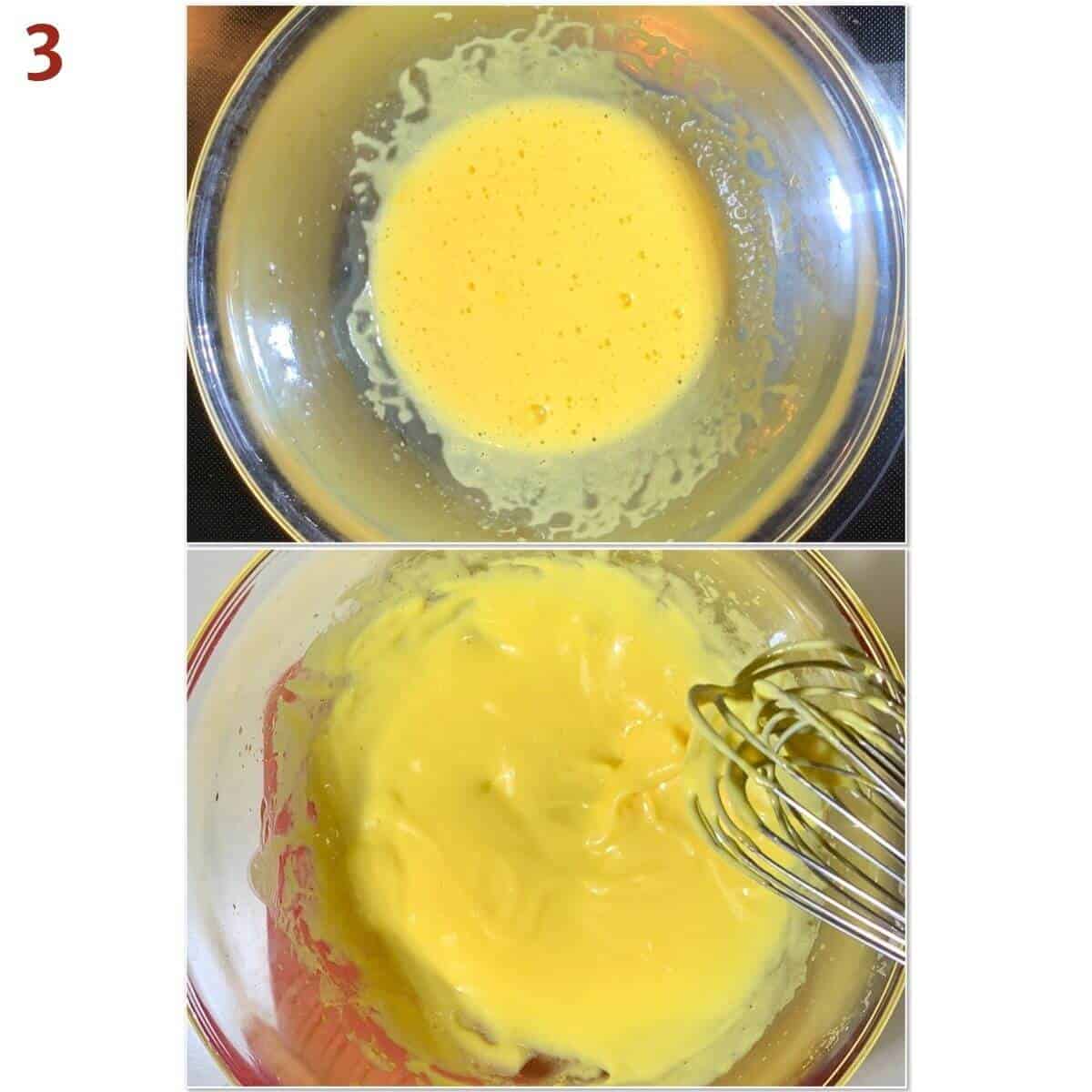
Step 4: Season to taste
Once all the butter is added and the hollandaise has thickened, remove the bowl from the saucepan. Check that the mixture has reached 149˚F as measured with a digital thermometer to confirm that the egg yolks are fully cooked.
Finish the sauce by whisking in the salt and cayenne pepper, if using (photo 4). Taste and adjust the seasonings as desired.
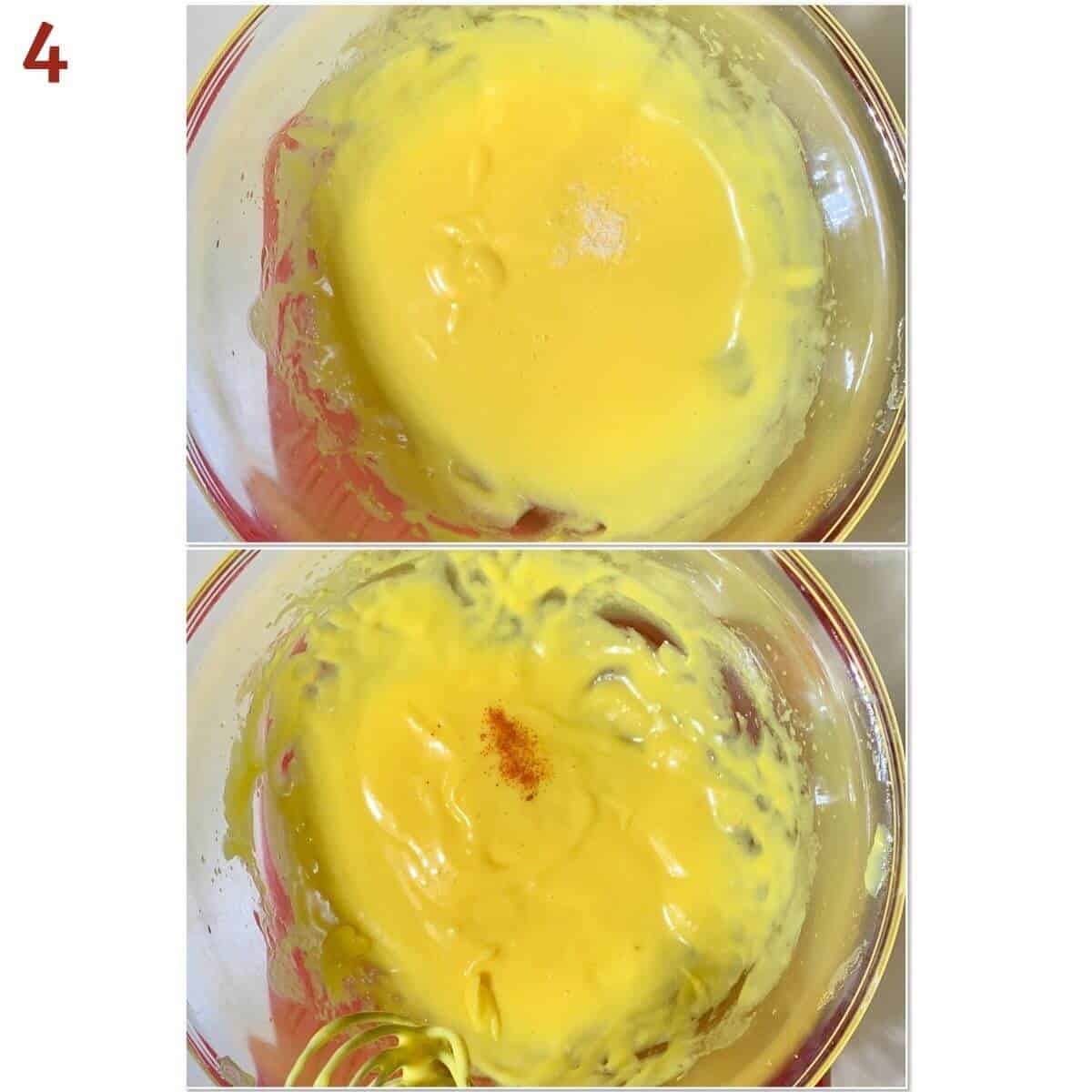
Storage instructions
Hollandaise sauce will keep in the refrigerator for 2 to 3 days, though it will firm up as it cools. For longer storage, For longer storage, freeze 1 tablespoon portions of the sauce in an ice cube tray until firm, then transfer to an airtight plastic bag for up to a month. Thaw overnight in the refrigerator, then re-warm as described below.
Yield Notes
This recipe makes about ½ cup of hollandaise sauce, and can be doubled.
How to Fix a Broken Hollandaise Sauce
It happens. I make a beautifully smooth hollandaise sauce the day before I need it. I'm re-warming it over some gently simmering water, get distracted by something shiny, and BAM!, my hollandaise sauce goes from smooth to separated in an instant.
There are 2 ways to fix a broken hollandaise:
- Whisk in a drop or two of hot water (but not more than 2 teaspoons) into the separated sauce, and see if that will bring the sauce together
- If that doesn’t work, put a single egg yolk in a bowl and slowly whisk in the broken sauce until everything smoothes out again (photo 5)
Make sure to check the seasonings before serving. And for Heaven’s sake, warm your hollandaise on a double boiler on low heat (and don’t get distracted!).

Questions asked and answered
Here are some questions you might have...
Hollandaise is an emulsion (meaning a mixture that doesn’t separate) of butter and lemon juice held together with egg yolks.
We all know that oil and water don’t stay mixed, and that's why you have to shake a vinaigrette salad dressing to temporarily combine them. For a more stable emulsion (like in classic Caesar salad dressing), keeping the fat and liquid from separating needs some help.
Lethicin, a substance found in egg yolks, acts as an emulsifier by attaching a water molecule to one end and a fat molecule to the other, thereby keeping them mixed. For a hollandaise recipe, the trick is to add the melted butter very slowly to a lemon and egg yolk mixture while whisking so the emulsion doesn’t “break” or separate.
You need egg yolks, patience, and a strong arm if you're making this sauce on the stove. A blender can help - the Internet is brimming with blender hollandaise sauce recipes that promise quick results with minimal effort. And that's fine if you're ok with possibly undercooked eggs.
However, in this instance I prefer to play it safe and gently cook the egg yolks over a double boiler. That’s the same reason I make a cooked vanilla custard when making homemade Eggnog. Once the mixture has reached 149˚F, the yolks are fully cooked and the sauce is pregnancy- and kid-friendly.
You can keep the sauce warm (about 145°F) in a double boiler, with the water just simmering as before. To avoid bacterial growth, don’t hold it at that temperature for more than 2 hours. Instead, chill the sauce in the refrigerator and re-warm when needed.
To re-warm it, very, very gently warm it in a double boiler, watching closely not to overheat (and break) the sauce. You can also use the microwave if you use low (20%) power for about 15 seconds, whisking between bursts.

Recipe

Classic Hollandaise Sauce (Double Boiler Method)
Equipment
- double boiler
Ingredients
- ½ cup unsalted butter, melted, see Recipe Notes
- 2 egg yolks, at room temperature
- 1 tablespoon lemon juice, at room temperature
- Pinch sea salt flakes
- Pinch cayenne pepper, optional
Instructions
- Make the clarified butter (optional): Gently heat the butter in a small saucepan (preferably with a lip for pouring) over medium heat. Allow the butter to foam (that’s the water boiling away). Skim off the foam occasionally. Keep an eye on the butter - you’re trying not to toast the milk solids at the bottom of the pan.
- Once the foam is mostly gone, the ghee is ready. Keep warm over very low heat until you're ready to use it. When drizzling later, try not to pour out the milk solids.
- Make the sauce: Place a medium saucepan on the stove with an about an inch of water. Heat the water until it’s simmering, then adjust the heat to low.
- Choose a bowl that can fit inside the saucepan (without it touching the bottom) to use as a double boiler. Combine the egg yolks and lemon juice and whisk until the eggs are pale and frothy. Fit the bowl inside the saucepan.
- With the heat on low, slowly drizzle the clarified butter into the bowl while constantly whisking the egg yolks until the mixture has thickened. Really, the stream should be very thin. The idea is to allow the butter and lemon juice to emulsify using the yolks. Go slow or your emulsion will separate.
- Once all the butter is added and the hollandaise sauce has thickened, remove the bowl from the saucepan. Check that the mixture has reached 149 °F as measured with a digital thermometer and the egg yolks are fully cooked.
- Finish the sauce by whisking in the salt and cayenne, if using. Taste and adjust the seasonings as desired.
- Serve over eggs, roasted vegetables, meat, chicken, fish, or whatever else you think will be enhanced by creamy, lemony goodness.
- To keep hollandaise warm: Keep the sauce warm (about 145 °F) in a double boiler, with the water just simmering as before. To avoid bacterial growth, don’t hold it at that temperature for more than 2 hours. Instead, chill the sauce in the refrigerator and re-warm when needed.
- To re-warm hollandaise: Very, very gently warm the hollandaise in a double boiler, watching closely not to overheat (and break) the sauce. You can also use the microwave if you use low (20%) power for about 15 seconds, whisking between bursts.
- To fix a broken sauce: If the sauce separates, fix it by whisking in a drop or two of hot water (but not more than 2 teaspoons). If that doesn’t work, put a single egg yolk in a bowl and slowly whisk in the broken sauce until everything smoothes out again. Check the seasonings before serving.
- Storage instructions: Hollandaise sauce will keep in the refrigerator for 2 to 3 days, though it will firm up as it cools. For longer storage, For longer storage, freeze 1 tablespoon portions of the sauce in an ice cube tray until firm, then transfer to an airtight plastic bag for up to a month. Thaw overnight in the refrigerator, then re-warm as described below.
- This recipe makes about ½ cup of hollandaise sauce, and can be doubled.






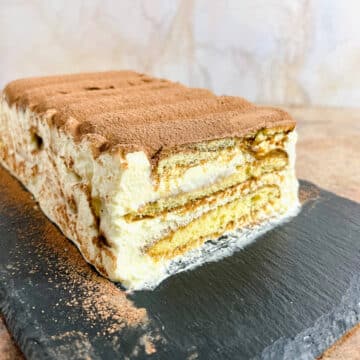

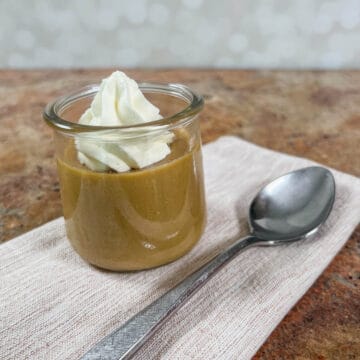


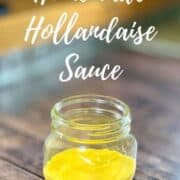
maria johnson says
can you process the hollandaise sauce in a boiling bath for canning?
Tammy Spencer says
Hi Maria, good question. Hollandaise sauce is very temperature sensitive, and placing the jar in a pot of boiling water would likely break the sauce. For long term storage, freezing it is your best option. Remember to reheat it very gently over a double boiler or use the microwave on low (20%) power for about 15 seconds, whisking between bursts.
Andy and Marg Sande says
I've tried twice, both times sauce is broken. First time I had the pot too hot and the egg cooked. Second time I don't think that was as issue. I was adding the butter about 1/8th teaspoon at a time, while whisking, then it started to thicken and I thought this looks promising and then it broke about 2 or three minutes in and I had only less than a quarter of the butter added. So I wasn't drizzling the butter in, but added a very small amount at a time. Is that the issue? The butter was clarified nicely.
Tammy Spencer says
Hi Andy & Marg, I’m sorry you were having trouble. Emulsifying the butter into the egg yolks can be finicky and frustrating. The key is to whisk constantly as you add a very small amount of the butter - even 1/8 teaspoon might be too much in your case. You also might try taking the bowl on and off the heat if you feel the mixture is getting too hot. I hope you were able to save your broken sauce using one of the methods I describe, and don’t give up - this definitely takes practice for you to find your groove. Good luck!
Stuck says
I really appreciate all your explanations of things. I've seen a couple other places that have placed an emphasis on adding the lemon juice immediately *after* the egg has been cooked because it helps to stop the egg from cooking. I'm surprised you don't do that given your clear understanding of the process. Are they wrong, or is this something about which you were not aware?
Tammy Spencer says
That’s an interesting question. I haven’t come across any recipes noting adding the lemon juice after cooking the eggs, so I really can’t comment on that idea. I do know that the recipe I gave does work, so as long as you follow the instructions to work slowly and carefully, you should be fine. Good luck!